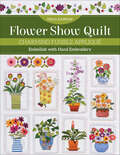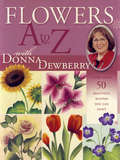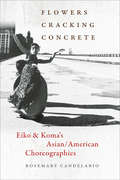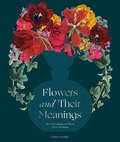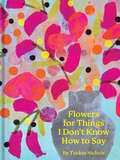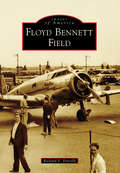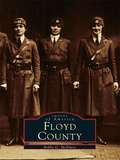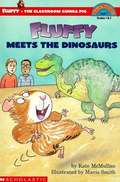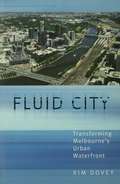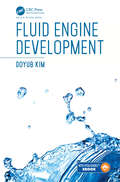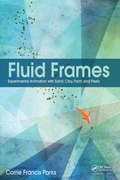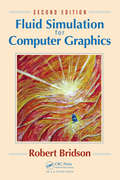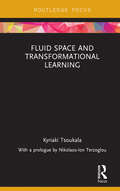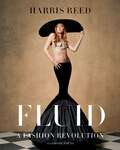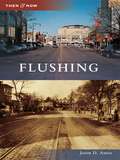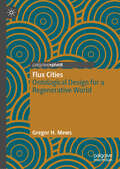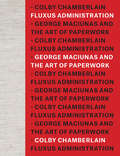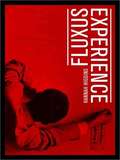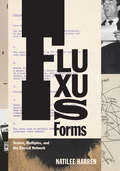- Table View
- List View
Flower Show Quilt: Charming Fusible Appliqué; Embellish with Hand Embroidery
by Erica KaprowFlower lovers rejoice for this intricate, 14-block quilt Do you love color, flowers, and appliqué? Combine these elements with delicate hand embroidery, and you have a gorgeous 14-block cotton quilt! This book for flower lovers includes instructions and full-size patterns for this 14-block (plus border) hand embroidered, appliquéd, and quilted cotton quilt by best-selling author Erica Kaprow. Beautiful bright colors are highlighted by simple embroidery embellishment, and the fusible appliqué is easy to do. Even beginners will find this project incredibly portable, perfect as an on-the-go project, an appliqué class, or a personal challenge! Uses simple embroidery stitches to embellish this floral quilt. Includes easy-to-follow instructions and full-size patterns for 14 blocks and borders Take traditional fusible appliqué and bloom with Erika’s colorful floral designs
Flowering: Easygoing Floral Design for Surprising Contemporary Arrangements
by Elizabeth JaimeA fresh, contemporary flower-arranging book from the Miami-based studio Calma Floral, with foundational tips, flower recipes, and bountiful photography that will teach you how to create irreverent arrangements for any occasion.Heralding a new era in floral design—one that favors a playful, modern aesthetic and a laidback approach—this guide to creating trend-forward flower arrangements invites you to think outside the box. Learn how to arrange unique, eye-catching bouquets by pairing unexpected combinations and incorporating a variety of elements and textures, such as fresh and dried blooms, rhinestones, fruit, and tropical foliage.Foundational tips for "flowering" set you up for success, and twenty step-by-step recipes (paired with step-by-step photos!) make it easy to design joy-filled floral moments—from a whimsical fountain of troll grass to a mossy mounded centerpiece, a Rococo-inspired piece worthy of Versailles, a suspended cloud of fluffy mimosa, and so much more. A must-have for hobbyists and experienced florists looking for something fresh, Flowering is the essential floral book for today.ONE-OF-A-KIND PIECES: With categories that include 360 Arrangements, Bud Vases + Tiny Arrangements, Party Time Flowers, Installations + Home Decor, and more, this book offers a wide range of flower design ideas. You'll find a piece for every occasion, whether you're looking for a bright bouquet of reflexed roses to gift to a friend, a table runner of carnations and candles for a dinner party, or an installation of dried palms to hang in your entryway.ALL-LEVEL DESIGNS: Flowering is perfect for weekend dabblers and professionals alike: Hobbyists and amateur designers will appreciate the informal tone, approachable how-tos, and step-by-step photography, which make creating these striking bouquets and arrangements easy and fun. Experienced florists will be inspired to try something new and different thanks to the book's creative inspirations.ON-TREND AESTHETIC: In a vibrant, colorful package, Flowering makes a fun gift alongside a vase, a candle, or an anthurium plant. Inspired by Calma Floral's youthful brand design, this trend-forward book is a must-have resource for millennials and Gen-Zers who like to have fun with flowers.FLOWER BOOK FOR A MODERN AUDIENCE: With a relaxed approach and chic style, Flowering is a refreshing update to the classic tomes on flower arrangement. Diverging from the tried and true, these 20 arrangements eschew tradition and make a bold statement with sculptural shapes and unique materials. Anyone eager for a new, exciting take on floral design will find it here!Perfect for:Hobbyists and weekend dabblers who want to have fun with flowersFlorists and floral designers looking for new inspiration and a fresh aestheticFans of the modern arrangements designed by Calma Floral, Bloom and Plume, and Under New MgmtShoppers looking for a Mother's Day, birthday, anniversary, or engagement gift
Flowers A to Z with Donna Dewberry: More Than 50 Beautiful Blooms You Can Paint
by Donna DewberryPainting your favorite flowers is easy with Donna Dewberry!Add the beauty and elegance of painted flowers to your projects. It's quick and fun with Donna Dewberry's popular one-stroke technique! This easy-to-use reference provides all of the instruction and inspiration you need to successfully paint more than 50 garden flowers and wildflowers in an array of stunning colors.Donna provides complete instruction beginning with step-by-step photos of her basic one-stroke painting technique. You'll discover the secrets of painting leaves, vines and other foliage common to a variety of flowers. With handy color charts and tips on painting flower petals of all kinds, you'll learn how to create unique floral designs that can be used on furniture, walls, picture frames and more, with fabulous results every time.
Flowers Cracking Concrete: Eiko & Koma’s Asian/American Choreographies
by Rosemary CandelarioFlowers Cracking Concrete is the first in-depth study of the forty-year career of Eiko & Koma--two artists from Japan who have lived and worked in New York City since the mid-1970s, establishing themselves as innovative and influential modern and postmodern dancers. They continue to choreograph, perform, and give workshops across the United States and around the world. Rosemary Candelario argues that what is remarkable about Eiko & Koma's dances is not what they signify but rather what they do in the world. Each chapter of the book is a close reading of a specific dance that reveals a choreographic theme or concern. Drawing on interviews, live performance, videos, and reviews, Candelario demonstrates how ideas have kinesthetically and choreographically cycled through Eiko & Koma's body of work, creating dances deeply engaged with the wider world through an active process of mourning, transforming, and connecting.
Flowers and Their Meanings: The Secret Language and History of Over 600 Blooms (A Flower Dictionary)
by Karen AzoulayUncover the secret meanings behind your bouquets and floral arrangements with this stunningly illustrated exploration of the Victorian language of flowers, including the multicultural history, rituals, and mythology behind over 600 flowers, herbs, and trees.In the Victorian language of flowers, hundreds of blooms were ascribed specific meanings based on folklore, science, and ancient history. Page through this botanical encyclopedia to learn each flower's Victorian meaning (ranunculus, for example, boldly states, "I am dazzled by your charms," while marigold represents despair), common names, and cultural history. There is also an index of the flowers grouped by theme, should you want to challenge your local florist to create a coded message for a loved one.The study of floriography can be used by readers to decode hidden messages in beloved novels like The Age of Innocence or speculate as to why two canary-yellow roses—which signify jealousy and infidelity—were featured in Diana Spencer's wedding bouquet. You might share some honeysuckle (meaning "bonds of love") with a friend or partner as a gesture of commitment. Or perhaps you'll choose a celebratory bouquet of angelica ("inspiration") and purple columbine ("resolved to win") for a friend who has triumphed over something difficult. Karen Azoulay pairs nineteenth century botanical drawings with electric photography, creating a one-of-a-kind flower dictionary with a contemporary, artful feel. With a foreword by Kate Bolick and a helpful sentiment-based index, Flowers and Their Meanings is both a beautiful volume and a practical guide to incorporating the language of flowers into your own life.
Flowers for All: Modern Floral Arrangements for Beauty, Joy, and Mindfulness Every Day
by Susan McLearyFlowers for All makes it easy to create gorgeous, modern flower arrangements that enhance everyday life with natural beauty. Celebrated floral designer Susan McLeary invites you to live a flower-filled life with botanical arrangements that encourage joy and connection. Driven by the belief that flowers should be enjoyed by everyone, McLeary does away with fussy ingredient lists and impossible-to-find botanicals. Here, she reveals the secrets to making striking, joyful floral displays using just a few ingredients.Organized into three sections—flowers for your home, flowers to gift, and flowers for larger celebrations—the book features 30 gorgeous arrangements, including an infinitely giftable monochromatic bouquet, a meditative petal display to inspire calm and clarity, a striking centerpiece for celebratory dinner parties, and a gorgeous wreath for festive gatherings. With sections on design techniques, flower care, vessel selection, and simple-to-follow instructions for each design, you'll be empowered to make magnificent arrangements at home—whether you buy your flowers at the local grocery store or cut them from your own garden.Delivered in a petite package full of expert tips and lush photos, this stunning handbook is a must-have guide for flower lovers, decor enthusiasts, and anyone who wants to immerse themselves in nature's beauty.FRESH TAKE ON FLORAL ARRANGING: This easy-to-follow arranging guide uses accessible ingredients and celebrates flower arranging as an opportunity to invite the beauty of nature into your life. The non-prescriptive approach makes it easy to learn the art of flower arranging, and the bold colors, monochromatic designs, and striking displays add a modern twist. FOR BEGINNERS AND MASTERS ALIKE: The approachable recipes and simple-to-find ingredients make these designs accessible to anyone, whether you get flowers at the grocery store, farmer's market, or your own picking garden. BEAUTIFUL GIFT: This colorful, flower-forward book is a thoughtful present for flower lovers, crafters, and decor enthusiasts. The petite, giftable size and attractive price make this a lovely gift to give with a bouquet of flowers and will brighten any gifting moment—from a housewarming party to Mother's Day. EXPERT AUTHOR: Susan McLeary is a beloved floral designer with decades of experience working with flowers. She leads online flower-arranging courses and teaches workshops all over the world to both beginner and experienced floral designers. Her work has been featured in Martha Stewart Weddings, Refinery29, Cosmopolitan, SELF, The Knot, and Country Living.Perfect for:Anyone with a passion for fresh flowers, flower arranging, gardening, or unique interior design ideasHikers, walkers, arboretum visitors, wildflower collectors, and all who cherish time in natureA lovely gift for moms, for Mother's Day, birthdays, or any special occasion, paired beautifully with gardening gloves, floral shears, decorative flowerpot or vaseFans of Susan McLearyReaders of Martha Stewart Living, Floret Farm's Cut Flower Garden, and Magnolia Table
Flowers for Things I Don't Know How to Say
by Tucker NicholsThis unique gift book is a reminder that whatever someone may be going through, they always deserve flowers.When it's the most difficult to find the right words, we turn to flowers to express our compassion and care. This book is like a bouquet of flowers in book form. Based on Tucker Nichols's celebrated multimedia art project entitled Flowers for Sick People, this book gathers vibrant floral paintings and pairs them with poetic dedications that pay tribute to a kaleidoscope of human experiences, from acts of unsung heroism to mundane moments of everyday beauty: "Flowers for Anyone Currently Eating a Cinnamon Bun in a Hospital Cafeteria," "Flowers for the Last Time You Laughed So Hard It Hurt," "Flowers for Spectacular Failures," and more. Deeply relatable and equal parts heart-wrenching and humorous, this book is a comfort and encouragement in any moment and a salve for the loneliness that can come in life's toughest times.INSPIRING PROJECT: PBS NewsHour spotlighted Tucker Nichols and his art for spreading kindness and connection during the isolating years of the pandemic. After inviting the public to submit names and addresses of their loved ones with illnesses, Nichols created and mailed original flower paintings to hundreds of requesters. This ongoing multimedia project evolved into the larger Flowers for series, which pays tribute to the vast array of moments and experiences that may be easy to overlook.ACCLAIMED ARTIST: Along with his multimedia art and health projects, Tucker Nichols also sculpts and makes art for publication. His work has been published in McSweeney's, The New Yorker, and the op-ed pages of the New York Times and exhibited in hospitals, art centers, and fine art museums across the globe. MEANINGFUL GIFT BOOK: This beautiful hardcover is like a bouquet of flowers, a caring gift not just in times of sickness, loneliness, and grief but whenever a loved one could use a little support or a thoughtful surprise. Full of colorful artwork and poetic text that speaks to all that we have to be grateful for—even when it's difficult—this book can be gifted in gratitude or sympathy to family and friends or to yourself as an act of self-care.Perfect for:Fans of Tucker Nichols and public art projects like Flowers for Sick PeoplePeople looking for uplifting encouragement and sympathy giftsFriends and family experiencing chronic illnesses, grief, or depressionAnyone who could use some flowers and words of affirmationMinimalist poetry lovers and fans of Rupi Kaur, Yung Pueblo, and Morgan Harper Nichols
Flowers, Butterflies and Insects: All 154 Engravings from "Erucarum Ortus" (Dover Pictorial Archive)
by Maria Sibylla MerianFine-line images of roses, butterflies, tulips, caterpillars, and other specimens of plant and insect life in elegant full-page compositions. These plates are considered among the finest achievements of a great age of floral painting and the engraver's art. Reprinted from the classic, influential works of the famed artist/entomologist Merian (1647-1717). New English captions.
Flowstones: Beautiful Creations From Polymer Clay
by Amy GoldinFlowstones are mesmerizing to look at and to hold—and they're easy to make! Conceived of by artist Amy Goldin, “flowstones” are crafted by molding a sheet of polymer clay around a smooth river rock. They impart a sense of calm to the holder, grounded by the weight and soothed by the smooth surface. Each stone’s unique shape and pattern gives it a beauty all its own. In Flowstones, Goldin shares beautiful photographs of the many stones she has created, captured in nature, where their striking appearance contrasts with landscapes of smooth river rocks, grassy parks, and sandy beaches. Goldin includes step-by-step illustrated instructions so even the most hesitant crafters can enjoy creating these delightful objects.
Floyd Bennett Field (Images of America)
by Richard V. PorcelliAlthough New York City was slowly recognizing the need for a municipal airport in the late 1920s, it sought to regain prominence by constructing the most advanced airport of its day. Construction in the far reaches of Brooklyn was started on October 29, 1929, the day of the stock market crash that heralded the Great Depression. The airport was named posthumously for Floyd Bennett, a Brooklyn native, Navy pilot, and Medal of Honor winner. Unfortunately, because of many factors--including poor timing, politics, and remoteness from Manhattan--the airfield was a commercial failure. Its advanced features, however, made it a mecca for private aircraft and the site of numerous record-breaking flights.
Floyd County (Images of America)
by Bobby G. McelweeFloyd County, Georgia, located in the picturesquenorthwest Georgia mountains, has a long and fascinating written history that stretches back to 1540 and the Spanish explorers of that era. The Mississippian, Creek, and Cherokee Nations preceded the arrival of Europeans to the area. Soon after, industry and commercial agriculture began to flourish, and in 1845, riverboats began carrying products down the Coosa River from Floyd County to Mobile, Alabama.
Fluffy Meets the Dinosaurs (Fluffy the Classroom Guinea Pig #9)
by Kate McmullanAges 6-8. Grades 1 & 2. When Fluffy the guinea pig learns that the class is visiting a dinosaur museum, he sneaks into Wade's lunch bag and joins the fun!
Fluid City: Transforming Melbourne's Urban Waterfront
by Kim DoveyFluid City traces the transformation of the urban waterfront of Melbourne, the re-vitalization of the Yarra River waterfront, Melbourne Docklands and Port Philip Bay. As the financial and industrial centre of Australia, in the late nineteenth century, Melbourne developed a new world exuberance. Yet the twentieth century saw Melbourne suffering from a declining industrial and economic base. The city in the 1980s was de-industrialising, and the re-facing of the city to the water was a key urban strategy of the 1980s and 90s and a catalyst for economic transformation. This book bridges significant gaps between different discourses about the city and to challenge singular ways of viewing the city.
Fluid Engine Development
by Doyub KimFrom the splash of breaking waves to turbulent swirling smoke, the mathematical dynamics of fluids are varied and continue to be one of the most challenging aspects in animation. Fluid Engine Development demonstrates how to create a working fluid engine through the use of particles and grids, and even a combination of the two. Core algorithms are explained from a developer’s perspective in a practical, approachable way that will not overwhelm readers. The Code Repository offers further opportunity for growth and discussion with continuously changing content and source codes. This book helps to serve as the ultimate guide to navigating complex fluid animation and development. Explains how to create a fluid simulation engine from scratch Offers an approach that is code-oriented rather than math-oriented, allowing readers to learn how fluid dynamics works with code, with downloadable code available Explores various kinds of simulation techniques for fluids using particles and grids Discusses practical issues such as data structure design and optimizations Covers core numerical tools including linear system and level set solvers
Fluid Frames: Experimental Animation with Sand, Clay, Paint, and Pixels
by Corrie Francis ParksOnce the realm of a few stalwart artists, animating with sand, clay, and wet paint is now accessible for all filmmakers with an experimental frame of mind. Created directly under the camera with frame-by-frame stopmotion, this "fluid frame animation" provides a completely unique visual world for animators. While pioneering animators such as Caroline Leaf, Alexander Petrov, and Ishu Patel paved the way, the availability of frame capture programs, compositing software and digital workflow is opening up new avenues of exploration for artists of all experience levels. This book will walk you through setting up your studio, choosing and working with your materials, and combining the physical under-the-camera production with digital compositing and effects to enhance your animation.· Firsthand advice from experimental animation veterans and rising stars in the field· Covers the digital aspects of experimental animation, including the latest techniques in After Effects CC· Tutorials and source files for under-the-camera approaches and After Effects enhancements on the book’s companion website In addition to the practical advice, you’ll find historical and contemporary examples of successful films, step-by-step tutorials for working under the camera and working with the footage digitally, and interviews and tips from artists who are currently pushing the boundaries in these experimental mediums. Stacked with information and images from over 30 artists, this book is an indispensable resource for both the student and professional wishing to get their hands dirty in an increasingly digital world.
Fluid Mechanics for Civil Engineers: SI edition
by N.B. WebberThis well-established text book fills the gap between the general texts on fluid mechanics and the highly specialised volumes on hydraulic engineering.It covers all aspects of hydraulic science normally dealt with in a civil engineering degree course and will be as useful to the engineer in practice as it is to the student and the teacher.
Fluid Screens, Expanded Cinema
by Janine Marchessault Susan LordAs a medium, film is constantly evolving both in form and in content. Fluid Screens, Expanded Cinema considers the shift from traditional cinema to new frontiers of interactive, performative, and networked media.Using the theories of Marshall McLuhan and Gilles Deleuze as a starting point, renowned scholars from the fields of film theory, communication studies, cultural studies, and new media theory explore the ways in which digital technology is transforming contemporary visual culture. The essays consider a series of questions: What constitutes the "new" in new media? How are digital aesthetics different from film aesthetics? What new forms of spectatorship and storytelling, political community, and commodity production are being enabled through the digital media?Using Gene Youngblood's 1970 book Expanded Cinema as an anchor for the volume, Fluid Screens, Expanded Cinema understands the digital not simply as a technological form, but also as an experience of space and time that is tied to capitalism. This important collection is unique in framing a range of social justice issues with aesthetic theories of new digital screen culture that will appeal to scholars and multimedia artists prepared to break new ground.
Fluid Simulation for Computer Graphics
by Robert BridsonA practical introduction, the second edition of Fluid Simulation for Computer Graphics shows you how to animate fully three-dimensional incompressible flow. It covers all the aspects of fluid simulation, from the mathematics and algorithms to implementation, while making revisions and updates to reflect changes in the field since the first edition. Highlights of the Second Edition New chapters on level sets and vortex methods Emphasizes hybrid particle–voxel methods, now the industry standard approach Covers the latest algorithms and techniques, including: fluid surface reconstruction from particles; accurate, viscous free surfaces for buckling, coiling, and rotating liquids; and enhanced turbulence for smoke animation Adds new discussions on meshing, particles, and vortex methods The book changes the order of topics as they appeared in the first edition to make more sense when reading the first time through. It also contains several updates by distilling author Robert Bridson’s experience in the visual effects industry to highlight the most important points in fluid simulation. It gives you an understanding of how the components of fluid simulation work as well as the tools for creating your own animations.
Fluid Space and Transformational Learning (Routledge Focus on Design Pedagogy)
by Kyriaki TsoukalaFluid Space and Transformational Learning presents a critique of the interlocking questions of ‘school architecture’ and education and attempts to establish a field of questioning that aspectualises and intersects concepts, theories and practices connected with the contemporary school building and the deschooling of learning and of the space within and through which it takes place. Tying together the historicity of architectural theory, criticism and practice and the plural dynamic of social fields and sciences, this book outlines the qualities and modalities of experiential fields of transformational learning. The three qualities of space that are highlighted along the way – activated, polyphonic and playful space – as they emerge (without being instrumentalised) through architecturalised spatial modalities – flexibility, variability, interactivity, taut fluid polyphony, multiplicity, transcendence of boundaries – tend to construct and establish a school environment rich in heretical socio-spatial codes. Meshing cooperative, participatory, intrapsychic and interpsychic dimensions, they invite the factors of learning to a creative, imponderable, transformational disorder and deconstruct dominant conditioned reflexes of a disciplinary, methodical and productive order.
Fluid: A Fashion Revolution
by Harris ReedIn Fluid, revolutionary fashion designer Harris Reed introduces the world to a new era in fluid fashion. At the centre of Harris Reed’s sartorial journey has always been his desire to change the way people express their identities through clothing. Fluidity’s essence is adaptable, evolutionary, and dynamic, and Harris’s work constantly disrupts the divide between men's and women's clothing. His pieces have been worn by Harry Styles, Adele, Sam Smith, Iman, and Beyoncé—and with each piece he has generated an instantly iconic cultural moment, pushing conversations about gender expression into the mainstream. Fluid examines historical antecedents of fluidity, questions old power structures, and urges people to find their authentic selves in this new avenue of fashion. With stunning photography, resplendent fashion, and illustrations of Harris's design process, Fluid takes readers beyond the idea of clothes as mere garments, reasoning that clothes are a nexus of art, philosophy, and history that can be used to help shape our culture and challenge understandings of gender. With this book, Harris Reed affirms that fluid is the future of fashion.
Flushing
by Jason D. AntosIn the 1890s, electric lighting and improved roads were just the beginning of the changes about to take place in Flushing, New York. Once a rural village of wide-open farms and magnificent estates, Flushing transformed into a community of more than 200,000 people and quickly became one of the busiest neighborhoods in Queens. Flushing explores these dramatic changes with many never-before-seen images. Jason D. Antos is the author of three other local history books: Whitestone, Shea Stadium, and Queens.
Flux Cities: Ontological Design for a Regenerative World
by Gregor H. MewsAs our larger life-giving systems that sustain livelihoods continue to erode at an unprecedented rate, and urban complexities continue to increase, this book presents a refreshingly unconventional, creative, and radical meditation on urbanism and city living. Greg Mews proposes the idea of &‘Flux Cities&’ and offers provocative new ways to inquire into non-linear relations to the city, through questions such as: How can we design from the heart? How to approach the real city and produce for (co)existence? How to navigate the intangible city? How to improve well-being through Flux Cities? Full of agency, Mews presents deep and personal insights on informal settlements, public space, and the role of Do-It-Yourself Urbanism in enabling spatial justice and regenerative practices towards well-being. A compelling read for anyone willing to shake up the normative existential foundations of cities.
Fluxus Administration: George Maciunas and the Art of Paperwork
by Colby ChamberlainA new, innovative approach to the work of Fluxus artist George Maciunas. Though widely recognized as the founder of the legendary Fluxus movement, George Maciunas has long been a puzzling figure in the history of twentieth-century art. Many have questioned whether he should be considered an artist at all. In Fluxus Administration, critic and art historian Colby Chamberlain reveals the consistent artistic practice hidden behind Maciunas’s varied work in architecture, music, performance, publication, graphic design, film, and real estate as an attempt to create models for community through structures of bureaucracy. In this deeply researched study, Chamberlain traces how Maciunas’s art insinuated itself into settings as unlikely as the routes of the postal service, the fine print of copyright law, the zoning strictures of urban planning, and the corridors of hospitals. These shifting frames of reference expand our understanding of where an artistic practice can operate and what forms it might assume. In particular, Chamberlain draws on media theory to highlight Maciunas’s ingeniously crafted paperwork, much of which is beautifully reproduced here for the first time.
Fluxus Experience
by Hannah HigginsHannah Higgins explores the influential art movement Fluxus. Daring, disparate, contentious--Fluxus artists worked with minimal and prosaic materials now familiar in post-World War II art. Higgins describes the experience of Fluxus for viewers, even experiences resembling sensory assaults, as affirming transactions between self and world.
Fluxus Forms: Scores, Multiples, and the Eternal Network
by Natilee Harren“PURGE the world of dead art, imitation, artificial art. . . . Promote living art, anti-art, promote NON ART REALITY to be grasped by all peoples,” writes artist George Maciunas in his Fluxus manifesto of 1963. Reacting against an elitist art world enthralled by modernist aesthetics, Fluxus encouraged playfulness, chance, irreverence, and viewer participation. The diverse collective—including George Brecht, Robert Filliou, Dick Higgins, Alison Knowles, George Maciunas, Yoko Ono, Nam June Paik, Benjamin Patterson, Takako Saito, Mieko Shiomi, Ben Vautier, and Robert Watts—embraced humble objects and everyday gestures as critical means of finding freedom and excitement beyond traditional forms of art-making. While today the Fluxus collective is recognized for its radical neo-avant-garde works of performance, publishing, and relational art and its experimental, interdisciplinary approach, it was not taken seriously in its own time. With Fluxus Forms, Natilee Harren captures the magnetic energy of Fluxus activities and collaborations that emerged at the intersections of art, music, performance, and literature. The book offers insight into the nature of art in the 1960s as it traces the international development of the collective’s unique intermedia works—including event scores and Fluxbox multiples—that irreversibly expanded the boundaries of contemporary art.
